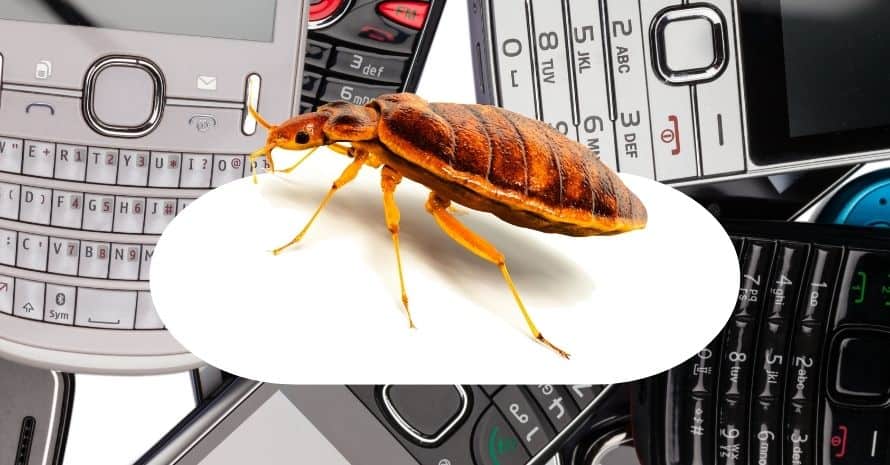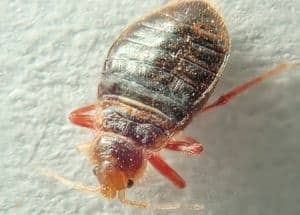Most people think of bed bugs as creatures that only live in mattresses and bedding, but these pests can also infest other areas of your home, including electronics. While bed bugs in electronics are not as common as in other places, it is still possible for them to hide in devices such as computers, TVs, and stereos. If you think you might have these parasites in your electronics, you might want to know how to get bed bugs out of electronics. There are a few things you can do to get rid of them, and I will discuss them below.
[wpsm_titlebox title=”Best Way How to Get Bed Bugs Out of Electronics” style=”main”]
Once you find where bed bugs are hiding, you need to get rid of them. The best way to do this is to vacuum them up. But be careful! Bed bugs can also hide in the crevices of vacuum cleaners, so make sure to empty the bag or canister immediately after vacuuming.
[/wpsm_titlebox]
Signs of a Bedbug Infestation of Electronics
Bed bugs can live for several months without feeding, and they are often found in mattresses, bed frames, headboards, bedding, furniture, and electronics.
There are a few signs of the bed bugs’ electronics presence:
- The first is finding them in or around your electronic devices. These pests are small, brown, and oval-shaped.
- Another sign of bedbugs in your electronics is the presence of small, dark spots on your devices. These spots are their feces, which can be a sign that parasites use your electronics as a food source.
- You start seeing small, brown bugs crawling around your electronic devices.
- Your devices begin to act strangely like they’re overheating or the batteries are draining quickly.
- You start getting bites on your body that you haven’t got before, and they seem to coincide with where your devices are placed when you’re using them.
Can Bed Bugs Harm Electronics?
These pesky little creatures love to bite and are notoriously difficult to get rid of, and it’s no more pleasant to find them in electronics. While these parasites don’t cause any serious harm to humans, they can wreak havoc on your electronic devices. These tiny insects are attracted to the warmth and darkness inside electronic devices, and they will happily settle and start breeding there.
They can cause damage to the circuitry of your electronic devices, and they can also be a nuisance if they bite you while you’re using your device. If you have bedbugs in your electronics, don’t panic. There are ways to get rid of them, and you can protect your devices from further damage.

Can Bed Bugs Get Into Cell Phones?
If you’ve ever had the misfortune of dealing with bed bugs, you know how difficult they can be to get rid of. If you’re not careful, they can spread quickly to other areas of your home, including your cell phone. They are attracted to the warmth and smell of humans and will crawl into any nook and cranny to get close to their host.
If you find signs of bed bugs, you might wonder how to get rid of bed bugs in cell phones.
- First, try to isolate the phone from other objects in your home. You can use a vacuum cleaner with a small attachment to suck up the bugs, or you can carefully disassemble your phone and clean it with alcohol. If you’re not sure how to clean your phone, you can always take it to a professional.
- Once you clean your phone of bed bugs, you have to take steps to prevent them from coming back. Start by decluttering your home and getting rid of anything that’s not essential. This includes items like clothes, newspapers, and magazines.
- Next, vacuum your home thoroughly, paying special attention to cracks and crevices. You should also wash all of your bedding in hot water to kill any bugs that might be lurking there.
- Finally, consider using a bed bug spray to help keep these pests at bay. Some sprays are designed to kill bed bugs on contact, while others create a barrier that prevents them from getting into your home in the first place.

Can Bed Bugs Live in Computers?
While you might not think your computer is a likely place for bed bugs to live, it still can happen. If you have these pests in your home, they might find their way into your computer.
The reason you might see bed bugs in a laptop computer is that they can survive for long periods without food. They can go without feeding for up to a year. They can also withstand a wide range of temperatures, from freezing cold to hot and humid.
They typically come out at night to feed. However, if you disturb them, they will bite during the day. Bed bug bites are usually painless but they can cause itching and swelling.
If your computer is infested with bed bugs, you might wonder how they got there. They’re experts at hiding, so it might be difficult for you to spot them until it’s too late. If you traveled recently and stayed in a hotel, these pests could hitch a ride into your home on clothing or luggage. They could also penetrate your house with used furniture. Once they’re inside, they’ll start to breed and multiply quickly, spreading over your entire apartment and entering electronics as well.
So how do you know if your computer has bed bugs? Look for small, brownish-red bugs crawling on the surface of your PC. They might also leave behind small, red stains. If you see any of these signs, it’s time to take action.

How to Get Bed Bugs Out of Electronics: Easy Extermination Guide
The first step is to identify: Do bed bugs hide in electronics? If you returned from a trip not so long ago, check your luggage and electronic devices for bed bugs. They often dwell in cracks and crevices, so be sure to check all the nooks and crannies of your gadgets.
Step 1. Unplug electronic device
Start by unplugging all of your electronic devices and taking them apart. This includes removing batteries, cords, or other adjustable parts. Once you dismantle all devices, inspect them for bed bugs. These insects are small, brown, and oval-shaped, so they can be hard to spot.
Step 2. Use a vacuum cleaner
Then vacuum all of the nooks and crannies of your electronics using a vacuum with a hose attachment. You can also use a stiff brush to remove bugs from your devices. Be sure to dispose of the vacuum bag or brush bristles in a sealed bag so that bed bugs can’t escape.
Step 3. Use a steamer or hair dryer
If the vacuum doesn’t seem to be doing the trick, you can try using a steamer hair dryer on your electronics. Be careful not to get the gadgets too wet, as this can damage them. Do not use too high-temperature settings.
Step 4. Wipe your devices with alcohol
After vacuuming, wipe down all of your electronics. Use a cloth dampened with rubbing alcohol.
Step 5. Use a pesticide
If you’re still seeing bed bugs at this point, you might need to use a pesticide. Be careful when using pesticides, as they can be harmful to your health. Next, take the device you are cleaning outside and spray it with bed bug spray. Be sure to follow the instructions on the label. You might need to repeat this procedure several times to kill all bed bugs. Use pesticides only as a last resort and always follow the manufacturer’s instructions. This will kill any remaining parasites and eggs.

Step 6. Seal any cracks
Finally, seal any cracks and crevices in the device with tape or a sealant. This measure will help you prevent bed bugs from returning.
Step 7. Get help from a professional exterminator
If you have a severe bed bug infestation, you might need to consult with a professional pest control company to completely get rid of the pests. In most cases, though, following the steps above helps get rid of parasites from your device.
Among the recommendations to remove these pests from electronics, I’d like to mention the cold. However, you need to be extremely careful, like when using heat. In both ways, you have to read the instructions for the device to understand which temperatures it can withstand.
If you have bed bugs in your electronics, it’s necessary to act quickly. These pests can quickly spread to other parts of your home, so it’s important to get rid of them as soon as possible. With a little effort, you can eliminate bed bugs in your electronics and keep your home pest-free.
How to Prevent Bed Bugs in Electronics
Now you understand why bed bugs are a nuisance. They’re small, hard to see, and can cause a lot of damage to your electronics. Luckily, you can do some things to prevent them from infesting your devices:
- First, keep your electronics clean. Vacuum the devices regularly to remove any dust or debris that can provide a hiding place for bed bugs. Pay special attention to crevices and seams where pests like to hide.
- Next, avoid using second-hand electronics. If there is no other option, carefully inspect a gadget for bed bugs before bringing it into your home.
- When traveling, inspect your electronics for parasites before taking them back into your apartment.
- Store your devices in a cool, dry place. Bed bugs prefer warm, humid environments.
By following these simple tips, you can help prevent bed bugs from infesting your electronic devices.
[su_youtube url=”https://www.youtube.com/watch?v=xSJgbzczdDY”]
FAQ About Bed Bugs in Electronics
After reading the above guide, you still might have some questions about these pests. Browse my answers to some commonly asked questions on the Web for the information you need.
How long can bed bugs live in electronics?
Unfortunately, there is no definite answer as it depends on a number of factors, including the temperature of the device and the presence of food (human blood). Bed bugs can survive for several months without consuming blood but will eventually die off. Bedbugs in a computer can live for months without blood as this dark place is favorable for them. However, they will not survive there as long as in a warm, sunny place like the inside of a TV.
Can bed bugs live in a laptop?
It is one of the places where these insects like to hide, so you can notice bed bugs in the laptop. Laptops provide the perfect environment for them to thrive. The heat generated by the laptop’s components creates a warm, dark space for bed bugs to hide in. Additionally, since people frequently use laptops, bed bugs have easy access to their food source.
How do you get rid of bugs in electronics?
Remove all electronic devices from the infested area. Vacuum all surfaces of the devices with a potent vacuum. Use a cotton swab or a soft brush to clean all ports and openings on the gadgets. Apply a bedbug-killing insecticide to all surfaces. Place the devices in a sealed plastic bag or a container.
People Evolve. So Do Bed Bugs
As the world becomes more and more digital, it’s no surprise that bed bugs are finding their way into our electronic devices. While bed bugs have traditionally been associated with uncleanliness and poor hygiene, they are now appearing in even the cleanest of homes. Since they’re so small, they can easily live undetected for months, making them a real nightmare for homeowners.
Dealing with bed bugs is never fun, but it’s important to remember that they’re not impossible to get rid of. With a little patience and perseverance, you will manage to get rid of them for good. Have you found insects in your PC or another device? What made you think they were bed bugs? Please, reply in the comments.

